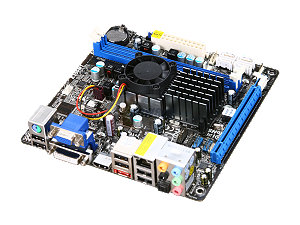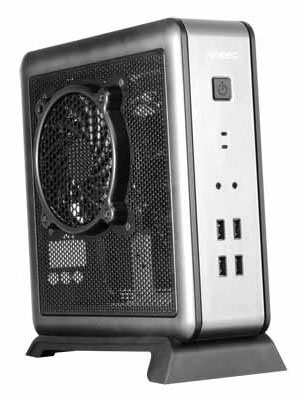Nettop and Mini-ITX Buyer’s Guide
by Zach Throckmorton on April 22, 2011 2:00 PM ESTAMD Zacate Budget Nettop
| AMD Budget Nettop | ||
| Component | Product Name | Price |
| CPU + Mobo | ASRock E350M1 (AMD E-350) | $110 |
| Memory | Patriot 2GB DDR3 1333 PSD32G13332 | $22 |
| Case + PSU | Antec ISK 100 + 90W PSU | $73 |
| Storage | Seagate Momentus 500GB 7200RPM 16MB | $60 |
| Operating System | Windows 7 Home Premium 64-bit | $100 |
| Total Price | $365 | |

Next up is our AMD variant of the budget nettop. We’ll start with the motherboard and CPU (APU) choice, the ASRock E350M1. AMD’s new Fusion APUs (Accelerated Processing Units) combine a dual-core CPU and DX11 graphics onto a single die. AMD refers to this as the E-350 for the dual-core model, and they call the GPU the HD 6310. We’ve already provided ample coverage of AMD’s new platform, and overall Brazos/Zacate is a much more pleasing solution than Intel’s Atom—or even NVIDIA’s ION. Really, there’s not much reason to go with the Intel Atom/ION systems in this guide over this budget AMD nettop unless you can find an Atom board on clearance somewhere. This ASRock board features an eSATA port, as well as VGA, DVI, and HDMI ports. It also uses regular desktop memory so make sure you get the correct type of RAM. We’ve selected a Patriot 2GB DDR3-1333 module, as 2GB is sufficient to run Aero and moderately multitask.

You could easily keep the same case, HDD, and DVDRW as the Intel system, but we’ve mixed things up a bit to provide some other options. This time, we’re going with the Antec ISK 100, which is my favorite mini-ITX enclosure. It includes a silent, high-efficiency 90W external power brick, a quiet but effective 100mm fan, four front USB2 ports, and space for two 2.5” hard drives mounted below the motherboard. Assembly is time-consuming, but the finished product is worth the effort in my opinion. Note that it does not have space for an optical drive, though you can always go the external drive route.
For storage, we’ve selected a Seagate Momentus 500GB 7200RPM drive. This is a drive that we’ve seen in dozens of laptops over the past year, and while performance is nothing like an SSD it will still get the job done. Unlike 3.5” drives, pricing is quite a bit higher, and the minimum ~$40 drives are usually 160GB 5400RPM models (or $45 for a 250GB drive). The choice of case thus ends up increasing the cost of storage, but we’re willing to make the trade in the name of style. You can choose a less expensive drive if you’re looking to cut costs, or perhaps if you want an optimal configuration you could buy a 60GB SSD for the OS and apps and add in a larger 5400RPM drive for mass storage, but that definitely wouldn’t be “budget” by any stretch.
With the selected components, the total system cost comes to $365, so for the added performance and flexibility over the Atom configuration you’re paying $37. If you use the same case and storage options as the Atom setup, the total drops to $355, making the difference just $27. This particular system is also slightly cheaper than the base mobo + CPU we’ll use in the higher-end Intel Atom + ION system, though the other component choices will bump the upgraded system cost up quite a bit. Considering that E-350 is a superior platform overall, the added price relative to stock Atom is worthwhile unless you’re sure you don’t care about Flash video support and other graphically intensive content. We’d prefer to give up hard drive space to afford the extra $27 relative to the base Intel setup, though.










101 Comments
View All Comments
JarredWalton - Saturday, April 23, 2011 - link
From the link you just gave: "How big of an issue this is depends on the user. Some can just ignore the judder, others will attempt to smooth it out by setting their display to 60Hz, while others will be driven absolutely insane by it."I'm guessing you're one of those that fall into the latter category. Most people that aren't HTPC enthusiasts probably don't even know there's a problem. Anyone using a laptop to watch Blu-ray for instance has to deal with various forms of judder caused by the 3:2 pulldown. Which is why we say, "You pretty much have everything you need for a decent HTPC...." Not a "perfect" HTPC, but a "decent" HTPC. Anyway, I'll make a note of the 23.976FPS issue in the article.
JohnMD1022 - Saturday, April 23, 2011 - link
newegg shows 2 SFX 80 plus PSUs for $50 (300w) and $54 (350w) plus shipping.Zap - Sunday, April 24, 2011 - link
If you were mentioning this because of the last system with the Thermaltake chassis, you need to be aware that it cannot take an SFX PSU that has a protruding fan, like the 300W Seasonic.gamefreakgcb - Saturday, April 23, 2011 - link
Specs:Antec ISK 300-150 mini-itx case (mentioned in this article)
Gigabyte H67N-USB3-B3
Intel i5 2500k
2x4GB Corsair XMS3
1x64GB SF-1200 Based SSD
1x500GB 2.5" platter (pending)
1x 5.25" slim DVD-RW (pending)
Internal 150W PSU (included with case)
The motherboard is the worst to pair with this case (all the headers i.e. sata, power, front panel, etc. are right next to the lone exhaust fan in the case), I have yet to play with undervolting the CPU, but stock everything (stock thermal paste with stock HSF and stock single exhaust) my temps reached as high as 80 with Prime95 and power draw never passed the 123 Watts at the wall (using the P3 Kill-A-Watt) and normal usage shows about 40 or so watts with light load (browsers with flash and the like, total idle is about 34 watts. I will get a chance to play with it tomorrow to see if I can bring the VCore down a bit, but the case is tiny, it fits vertically in the CD Tower Rack on my desk. It is very very snappy (even with a lone Kingston SSD, which I will most likely upgrade to an Intel 510 series), and fairly quiet (I do not need extreme silence). I would like reviews of some more mini-itx cases on this site though. I only accidentally stumbled upon this case.
dagamer34 - Saturday, April 23, 2011 - link
I'd say ditch large hard drives in HTPCs and go with SSDs instead. A 60GB drive is $100-120, and in a truly networked home, most of your media should be stored on a server anyway. This way you get quick sleeps, resumes, and reboots, making it much closer to an embeddable electronic part than a PC.JarredWalton - Saturday, April 23, 2011 - link
Resume (from sleep) is usually quite fast on Win7, and who really cares how fast a system goes to sleep? If you're putting it to sleep, you walk away and whether it's asleep 5 seconds later or 60 seconds later really doesn't matter. (Interesting note: I think part of the reason Win7 sleeps so slowly is that it usually does a "sleep + hibernate", so if power goes out it can still resume from the HDD image. At least, I have two systems that do that.)Anyway, we mention the SSD + HDD option on both upgraded systems. It really depends on what you plan to do with a system, and if you're mostly storing video for HTPC use the benefit of a $100 SSD upgrade is questionable. If you're using it as a general PC much of the time, by all means go for it. Personally, I wouldn't bother with an SSD unless I was already using a faster processor than Atom/Brazos, but I know some people want an SSD on any system they use.
Xorg - Saturday, April 23, 2011 - link
The problem with all of these small form factor systems is NOISE. i have yet to use or see one that didn't sound like a vacuum cleaner under load.obarthel - Sunday, April 24, 2011 - link
Passive Asus board in a passively cooled M-350 ? Optional quiet 4cm fan (whichever brand/model) if required ?AgeOfPanic - Saturday, April 23, 2011 - link
Nice article and a good introduction to some cool little hardware. I immediately started to pick out some hardware for a build of my own. Then I talked to my brother and I realized another option for for the budget Zacate system. Why not buy a netbook with almost the exact same hardware? That way, you are mobile and at home you just attach it to a larger screen.Costs a little more, but definitely expands the possibilities as well. The only reason to go with a nettop for me would be to have faster hardware, maybe based on Intel H55 or something.obarthel - Sunday, April 24, 2011 - link
Very true that. We can get1- Netbook @400 euros incl. Windows. 11.6", 2Megs, 320Gigs E-350 MSI netbook. Windows license included. Portable, but not very elegant for Desktop, HTPC, or NAS use and possibly not too quiet. Only 1 internal HD, so no SSD, or get a large+expensive one to hold OS+Apps+Data, or a small one for OS+Apps and an external HD for data. Add +40 for 4GB RAM, +120 for 1TB HD, +100 for a 60GB SSD
2- Homebrew @400 euros w/o OS (+100 for Windows) nor screen nor KBMS (+60 for MS ARC series), 4 megs, 1TB HD+ 60GB SSD, VESA-mountable M-350 case. Internal HD+SSC possible with the M-350 case (130 euros for case+PSU+picoPSU+VESA mount+2nd HDD bracket, though). Perfect fit for my needs, but expensive compared to the Netbook or...
3- Premade Nettop @390 euros w/o OS (+100 for Windows) nor screen nor KBMS +60 again): Zotac ZBOX AD02 (E-350, no ram, no HD) for 250euros , and add 4MB RAM (+40) and 1TB disk (+100).
So Netbook turns out cheaper if you want Windows, and the portability is nice. If you don't need portability, nor Windows, homebrew or premade are cost-competitive, especially if you don't care about keyboard and mouse or have extras lying about, and allow you to get exactly what fits your needs. In my case, I'd like to have an SSD since everybody says it makes such a huge difference, and I'd like to complete my move to Linux after a successful tryout on my current Atom Netbook (so I don't need portability, either)... SO I'm trying to convince myself that playing around building my own stuff and shelling out 130 for the M-350/PSU/picoPSU/mount and whatnot makes sense. Activating reality distortion field NOW....